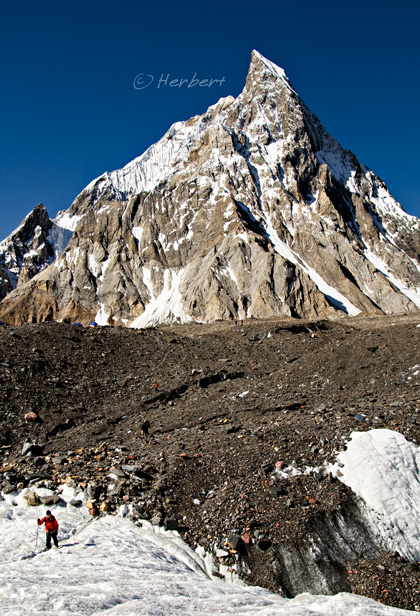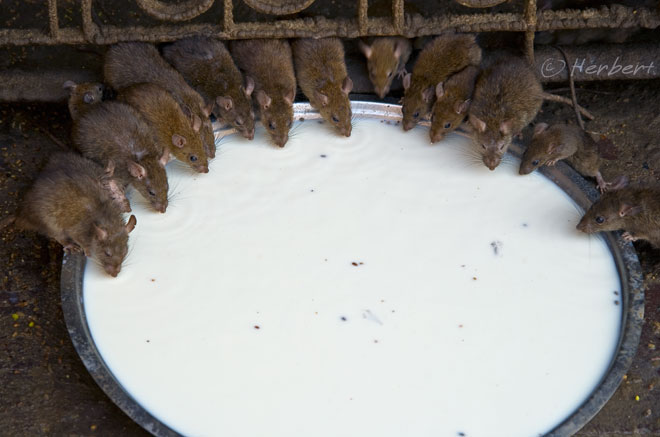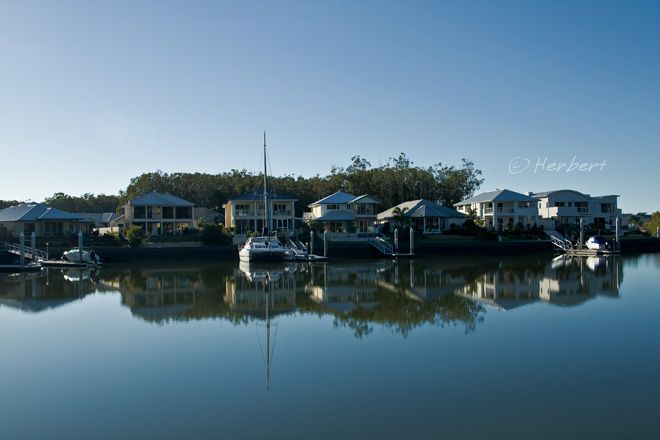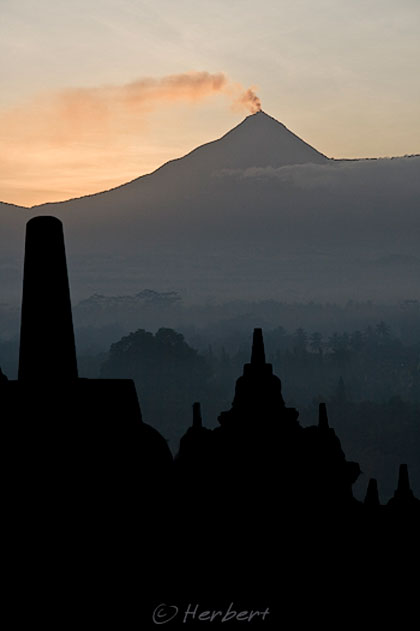November 30, 2009
November 25, 2009
Mighty Mitre Peak at Concordia, Pakistan

Location: Mitre Peak at Concordia, Pakistan (35.7°N 76.48°E)
Date: 10 July 2007; 11.25am
Camera: Canon 400D with Sigma 17-70/f2.8-4.5
One of the best places on earth to enjoy mountainscape is the Concordia of Pakistan. Nepal and Tibet are great places as well, especially for the Himalayan Mountains and of course Mount Everest (Sagarmartha in Sherpa language and Qomolongma in Tibetan). Concordia is special compared to the other two because it is not Himalaya (ha,ha) but Karakorum, which to me is more spectacular with their more jagged and muscular profile. Furthermore, Everest can be seen at these two other places with relative ease- one can fly by helicopter to the Everest View Hotel at Khumjung (Nepal) or drive on a 4WD all the way to the so-called Everest Base Camp in Tibet, China. However, if one wants to see K2 (the second highest mountain on earth), there are no shortcuts- one will have to trek many days including sleeping on glaciers- to the Concordia. One of the most distinct mountains at Concordia is the Mitre Peak (6,010m). The Mitre Peak here is prettier and looks more like the Christian bishops’ mitre headwear than its namesake in Milford Sound of New Zealand.
November 23, 2009
Sunset behind Mitre Peak at Milford Sound, New Zealand

Location: Mitre Peak at Milford Sound, South Island, New Zealand (44° 38′ 0″ S, 167° 51′ 0″ E)
Date: 23 May 2009, 5.30pm
Camera: Canon 400D with Sigma 17-70/f2.8-4.5
Mitre Peak at Milford Sound is one of the most photographed places in New Zealand. It was named so after the mitre headwear of Christian bishops (it is not nearly as perfect and pretty as another Mitre Peak in the Concordia area of Pakistan- I will post an article on that soon). At 1,692 metres, it is not a tall mountain but it sticks out as the surrounding mountains are lower. Most people would come to Milford Sound to take the Milford cruise on the sound itself. The cruse and the ride on the Milford Road to the Sound is like one of the must-do for any travellers to New Zealand and is normally done as a package from nearby towns such as Te Anau or Queenstown. However one can actually stay at the Milford Lodge, which is 5 minutes walk to the cruise centre (where this photo was taken). The Lodge has bunks and backpackers facilities at a cheap rate. One can only enjoy the tranquility and take some good sunset/sunrise photos by spending a night around here.
November 20, 2009
View of Everest, Lhotse, Makalu and Ngozumpa Glacier from Gokyo Ri, Nepal

Location: Mountainscape from Gokyo Ri, Nepal (27°57'41.69"N 86°40'56.79"E)
Date: 14 April 2000; 7.45am
Camera: Canon EOS 500N (analogue) on slides and scanned
There are two great spots to see Mount Everest (from here on, respectfully referred to as Sagarmartha, which is its Sherpali name, in this article) in the Khumbu area of Nepal, where trekkers normally trek to. One of them is obviously the so-called Everest Base Camp trek that brings one very close to the foot of Mount Sagarmartha. This is very close and the view may be grand but not spectacular. The other one is from Gokyo Ri (5,357m) further east. Gokyo Ri is close to the village of Gokyo (visible in the photo), on the banks of the third Gokyo Lake (also called Dudh Pokhari). The view of Sagarmartha is further (and smaller) from here but perhaps a little more spectacular, blending in the surrounding peaks (Sagarmartha is the peak partially hidden by clouds, towards the left side of the above photo). In fact, a few other 8,000m peaks can be seen from here- Lhotse, Makalu and Cho Oyu- as well as perhaps the largest glacier in Nepal- Ngozumpa Glacier (in front of the mountain range in the above photo). However, to me, a better and more spectacular view of Sagarmartha is the southeast face i.e. from the China-Tibet side.
November 18, 2009
Modern Tibetan cowboys at Xiahe, Gansu, China
 Locations: Xiahe, Gansu, China (35° 11' 50 N, 102° 30' 36 E)
Locations: Xiahe, Gansu, China (35° 11' 50 N, 102° 30' 36 E)Date: 26 June 2004; 5.40pm
Camera: Canon 300D with kit lens
Xiahe is a small town in present-day Gansu. It used to be part of Greater Tibet in the old days and hence, the town is still very predominantly Tibetan in every sense of the word. It is also the location of Labrang Monastery, one of the largest Tibetan Buddhist monasteries outside of the Tibet Autonomous Region. These days, the Tibetans here have substituted their choice of transport from horses while roaming in the mountains and grassland to “steel horses” i.e. the motorbikes. It is common sight to see groups of young Tibetans with their customary cigarette in their mouths on motorbikes gathering to update on the latest developments on the grasslands.
November 15, 2009
These rats are fun, Kami Mata Temple, Deshnok, India

Location: Rats feeding on milk, Deshnok, Rajasthan, India (27° 47′ 26″ N, 73° 20′ 27″ E)
Date: 10 Jan 2009; 9.30am
Camera: Canon 400D with Sigma 17-70/f2.8-4.5
Kami Mata was a female Hindu sage worshipped as an incarnation of Durga. There were several temples built and dedicated to her. The most famous of all is the temple in Deshnok, a village south of Bikaner in Rajasthan. The temple is famous for its rats, known as kabas and is supposedly reincarnations of a family who have a member revived by Kami Mata. These rats, literally in the thousands, run riot over the temple complex, dashing around to feed on the food- fruits, sweets and so on- and milk left by pilgrims and worshippers. The rats vary in sizes but most of them are rather small. They are harmless and are quite fun to watch. There are holes around the temple courtyard to fascinate the rats' movements. It is considered auspicious to have a kaba running around and/or across your feet.
November 13, 2009
The sea of yellow that is rapeseed blooming, Yunnan, China

Location: Luoping, Yunnan, China (31° 15' 0 N, 110° 4' 60 E)
Date: 1 March 2007, 5.20pm
Camera: Canon 400D with Sigma 17-70/f2.8-4.5
Canola or more commonly known as rapeseed is a major source of cooking oil in China. Many parts of China are planted with rapeseed, which normally ripens in the warm of spring. However, as different places in China are located in different attitudes and heights, the ripening and harvest season of rapeseed varies from place to place. Places like Yunnan (like Luoping in the photo), parts of Guangxi, Guizhou etc (all in the south) will have theirs in Feb/Mar while those in places such as Qinghai, Xinjiang will be latter months. When the rapeseed flowers are in full bloom, the plantations and surrounding areas is a sea of yellow and gold. All one can see is just a yellow and golden blanket with the buildings, trees and other fixtures in between. One of the most spectacular places to enjoy this beauty is the Luoping area in the east of Yunnan (at the border with Guizhou and Guangxi).
November 11, 2009
The Good Life, Aussie-style in Gold Coast, Queensland, Australia

Location: Somewhere near Gold Coast, Queensland, Australia (27°51'5.88"S 153°21'46.67"E)
Date: 13 May 2008, 10.15am
Camera: Canon 400D with Sigma 17-70/f2.8-4.5
To many Asians where property prices in cities are expensive and most abodes are small, Australia really seems like the “Lucky Country” where large houses with huge gardens are relatively cheap. That’s why many middle class Asians chose to buy a place and retire in Australia. The only thing that works against that dream is the higher costs of living as well as the current high exchange rate. One only needs to survey the bigger Australian cities such as Sydney, Melbourne, Brisbane, Perth and so to notice the huge Asian influx. The change is so profound in the last 15 years that when I told one of my Australian friends that I wanted to have Australian food, he asked if I want to have Vietnamese, Thai or Malaysian style.
November 9, 2009
Even Ronnie McDonalds do the Thai gesture in Thailand

Date: 28 October 2009, 11.15am
Camera: Canon 400D with Sigma 17-70/f2.8-4.5
Thailand is known as the “land of smiles” but probably more accurately refers to as the “land of politeness”. Thais has a special way of greeting known as wai. This consists of a slight bow with hands clasped together as if in a prayer. If the hands are held higher in relation to the face and a lower bow, more respect or reverence is being shown by the wai giver. The wai is also commonly used as a gesture of thanks or seeking forgiveness. It is speculated that the wai originated from an ancient greeting as a means to show that neither individual had any weapons. However, it is more likely to originate from Buddhist tradition where one claps their hands together and bring it down towards the ground three times after prayers.
November 6, 2009
Sunrise rays on Gunung Merapi at Borobudur, Java, Indonesia
Location: Borobudur, East Java, Indonesia (7°36′29″S 110°12′14″E)
Date: 21 July 2008; 6.00am
Camera: Canon 400D with Sigma 17-70/f2.8-4.5
Borobudur is the largest Buddhist monument in the world. Many tourists like me get up early to enjoy the view of the sunrise over Gunung Merapi looming over Borobudur in the distance. It is also a better time to take it the site as there are less tourists about because those on tourist buses do not normally troop in till around 10am. The best strategy to enjoy this morning serenity had already been described here.


















